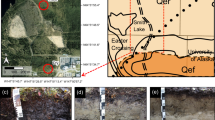Abstract
Organic-accumulative horizons above the permafrost table have been described in the profiles of cryozems developing on interfluve surfaces in the tundra zone of northern Yakutia. The organic matter content in these suprapermafrost horizons is comparable with or even exceeds the organic matter content in the surface horizons. The dynamics of seasonal thawing specify the annual involvement of the material of these horizons into the zone of active pedogenesis or its exclusion from it in the case of their frozen state. The analysis of the morphology of cryozems of the Kolyma Lowland along a 1000-km-long sublatitudinal transect shows that the accumulation and migration of raw organic materials (predominantly, differently decomposed peat) above the permafrost table take place upon the particular combinations of local factors (the soil moistening, ice content, freezing-thawing conditions, nanotopography of the permafrost table, etc.) at the lower boundary of the active layer. The well-pronounced accumulation of the raw organic material in the suprapermafrost horizons can be reflected in the substantive characteristics of these horizons and should be taken into account in classification decisions.
Similar content being viewed by others
References
J. Bockheim, J. M. Kimble, Ch. Tarnocai, and C.-L. Ping, “Gelisols: A New Order of Soil Taxonomy,” in Results of Fundamental Investigations of the Earth’s Cryosphere in Arctic and Subarctic Regions (Mater. Int. Conf. in Pushchino, Apr. 23–26, 1996) (Nauka, Sib. otd., Novosibirsk, 1997), pp. 287–297 [in Russian].
Vasil’evskaya, V.D., Soil Formation in the Tundra of Central Siberia (Nauka, Moscow, 1980) [in Russian].
G. F. Gravis, “Frost Cracking of Soils and the Formation of Humus Flows,” in Permafrost and Related Phenomena in the Yakutian Autonomous Republic (Izd. Akad. Nauk SSSR, Moscow, 1962), pp. 112–123 [in Russian].
S. V. Gubin, “Dynamics of the Permafrost Table and the Problem of Humus Retention in Tundra Soils of the Northeast of Russia,” in Problems of Soil Evolution (Mater. IV All-Russia Conf.) (Pushchino, 2003), pp. 168–172 [in Russian].
S. V. Gubin, Paleogeographic Aspects of Soil Formation on Coastal Lowlands in the North of Yakutia (Pushchino, 1987) [in Russian].
S. V. Gubin, Extended Abstract of Doctoral Dissertation in Biology (Pushchino, 1999) [in Russian].
S. V. Gubin, A. V. Lupachev, A. O. Alekseev, and P. I. Kalinin, “Lateral Transfer of Substances above the Permafrost Table in Permafrost-Affected Soils,” Tez. Dokl. Nauchn. Konf. Russia in the IPY 2007/2008 (Oct. 3–5, 2006) (Sochi, 2006), pp. 3–5 [in Russian].
S. V. Gubin and A. V. Lupachev, “Soil Formation and the Underlying Permafrost,” Pochvovedenie, No. 6, pp. 655–667 (2008) [Eur. Soil Sci. 41 (6), 574–585 (2008)].
L. G. Elovskaya, E. I. Petrova, and L. V. Teterina, Soils of Northern Yakutia (Nauka, Novosibirsk, 1979) [in Russian].
T. N. Zhestkova, M. I. Zabolotskaya, and V. V. Rogov, Cryogenic Structure of Frozen Rocks (Izd. Mosk. Gos. Univ., Moscow, 1980) [in Russian].
I. V. Ignatenko and B. N. Norin, “Dynamics of Patchy Tundra in the Northeast of Europe,” Probl. Botaniki 11, 72–90 (1969).
T. N. Kaplina, O. V. Lakhtina, and N. O. Rybakova, “History of Landscape and Permafrost Development in the Kolyma Lowland according to the Radiocarbon, Cryolithological, and Palynological Data,” in Geochronology of the Quaternary Period (Nauka, Moscow, 1980), pp. 171–189 [in Russian].
Classification and Diagnostic System of Russian Soils (Oikumena, Smolensk, 2004) [in Russian].
N. S. Mergelov, Extended Abstract of Candidate’s Dissertation in Geography (Moscow, 2007) [in Russian].
S. V. Tomirdiaro, “Cryogenic Evolution of Plains in the Northeast of Asia in the Late Glacial Epoch and in the Holocene,” Izv. Vses. Geogr. O-va, No. 2, pp. 124–132 (1975).
D. G. Fedorov-Davydov, S. P. Davydov, A. I. Davydova, et al., “Spatiotemporal Regularities of Seasonal Soil Thawing in the North of the Kolyma Lowland,” Kriosfera Zemli 8(4), pp. 15–26 (2004) [in Russian].
L. A. Fominykh, “The Peculiarities of Soil Formation in the Kolyma Tundra,” Pochvovedenie, No. 8, pp. 917–925 (1997) [Eur. Soil Sci. 30 (8), 811–819 (1997)].
A. L. Kholodov, E. M. Rivkina, D. A. Gilichinskii, et al., “Assessment of the Amount of Organic Matter Discharged into the Arctic Basin upon Thermal Abrasion of Coasts of the Laptev and East Siberian Seas,” Kriosfera Zemli 7(3), pp. 3–12 (2003).
N. A. Khotinskii, “Holocene Chronosequences: Debatable Problems of Paleogeography of the Holocene,” in Development of the Environment of the USSR in the Late Pleistocene and Holocene (Nauka, Moscow, 1982), pp. 207–219 [in Russian].
Yu. L. Shur, Upper Permafrost Layer and Thermokarst (Nauka, Novosibirsk, 1988) [in Russian].
V. K. Yanovskii, “The Pechora Expedition to Determine the Southern Boundary of Permafrost,” Report of the Committee on Permafrost Studies (Izd. Akad. Nauk SSSR, Moscow, 1933) [in Russian].
A. Alekseev, T. Alekseeva, V. Ostroumov, et al., “Mineral Transformations in Permafrost-Affected Soils, North Kolyma Lowland, Russia,” Soil Sci. Soc. Am. J. 67, pp. 596–605 (2003).
J. G. Bockheim and C. Tarnocai, “Recognition of Cryoturbation for Classifying Permafrost-Affected Soils,” Geoderma 81, pp. 281–293 (1998).
D. G. Fyodorov-Davydov, A. L. Kholofov, V. E. Ostroumov, et al., “Seasonal Thaw of Soils in the North Yakutian Ecosystems,” Ninth Int. Conf. on Permafrost (Fairbanks), 1, 481–486 (2008).
Y. L. Shur and C. L. Ping, “Permafrost Dynamics and Soil Formation,” Proc. Meet. on Classification, Correlation and Management of Permafrost-Affected Soils, July 18–30, 1993, Alaska, USA and Yukon and North-West Territories, Canada (USDA, SCS, Ottawa, 1994), Vol. 1, pp. 112–117.
Y. M. Shur, K. M. Hinkel, and F. E. Nelson, “The Transient Layer: Implications for Geocryology and Climate Change Science,” Perm. Perigl. Proc. 16, pp. 5–17 (2005).
C. Tarnocai, J. G. Canadell, E. A. G. Schuur, et al., “Soil Organic Carbon Pools in the Northern Circumpolar Permafrost Region,” Glob. Biogeochem. Cycles 23(2), GB2023 (2009).
The Canadian System of Soil Classification 2nd Ed. (Agriculture Canada Publ., Ottawa, Ont., 1987).
Author information
Authors and Affiliations
Corresponding author
Additional information
Original Russian Text © A.V. Lupachev, S.V. Gubin, 2012, published in Pochvovedenie, 2012, No. 1, pp. 57–68.
Rights and permissions
About this article
Cite this article
Lupachev, A.V., Gubin, S.V. Suprapermafrost organic-accumulative horizons in the tundra cryozems of northern Yakutia. Eurasian Soil Sc. 45, 45–55 (2012). https://doi.org/10.1134/S1064229312010115
Received:
Published:
Issue Date:
DOI: https://doi.org/10.1134/S1064229312010115




